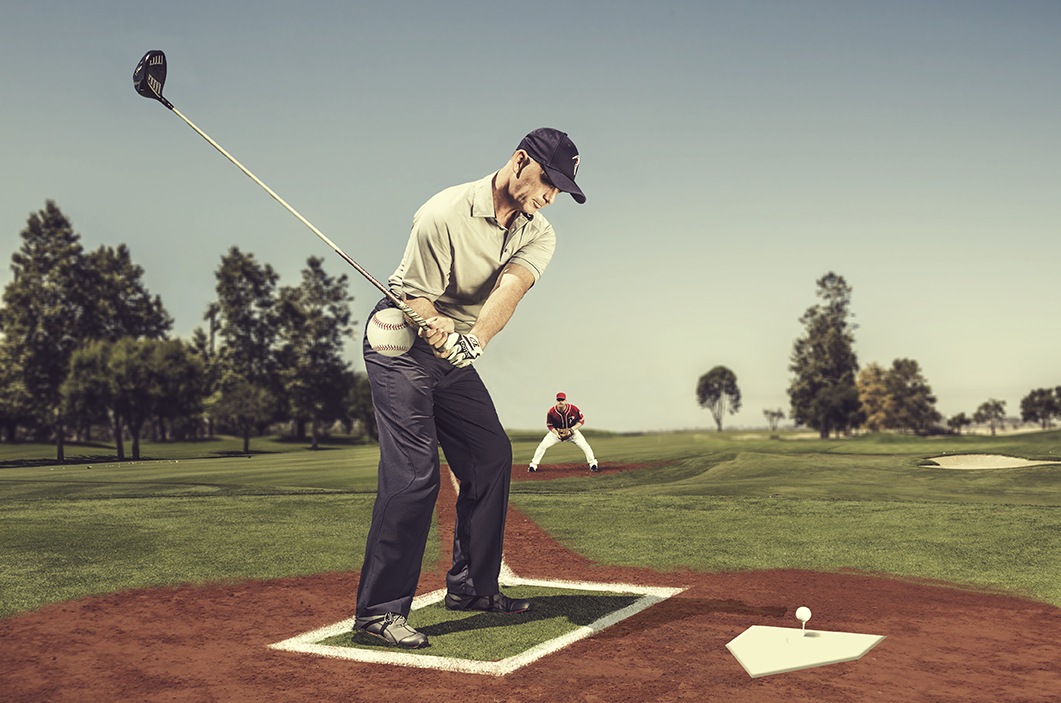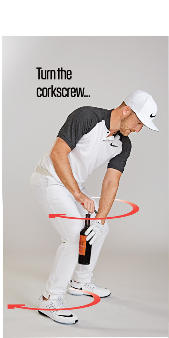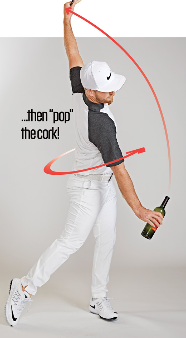IMPROVE MY GAME
Articles
Say the Magic Words: Internal vs External Coaching Cues

Did you know that popping a bottle of wine can help you drive a golf ball 300 yards? No, I'm not suggesting you skip today’s lesson or workout for happy hour, but when used as an external cue, “popping a bottle of wine” can be quite powerful.
In the May 2017 issue of Golf Magazine, winner of the Valero Texas Open and rising PGA TOUR star Kevin Chappell provides several tips to unlock power, increase swing speed, square up at impact and other desired results. What made this article standout is how he and his swing coach, Top 100 teacher and TPI instructor Mark Blackburn focus on images instead of swing positions. So get out your favorite red or white and keep reading.
One such image involved popping the cork on a wine bottle.
“I’m averaging 299 yards off the tee this season – not bad for a guy with a fairly short backswing. Correctly using my lower body makes up the difference. My coach, Top 100 teacher Mark Blackburn, has helped me learn how to leverage the ground to create speed naturally, instead of forcing it with my arms. I liken Mark’s lessons to opening a bottle of wine. As you start back, picture your right leg twisting into a cork. Push down hard with your right heel and literally “crank” your right foot clockwise into the turf. Done correctly, you’ll feel your right glute tense, a sign that you’ve loaded sufficient energy into your right side. Now the fun part: As soon as your right glute tenses, yank the cork out of the bottle – hard! Imagine the cork is slightly stuck, and that it takes a full-body, upward thrust to “pop” it out. I like to feel as if my left hip is pulling up and back through impact – that’s a huge key for accuracy and power.” - Kevin Chappell (Chappell & DeNunzio, 2017)


Imagery creates a powerful picture.
At the beginning of my career, I was lucky enough to learn this method first hand. While attending a multi-dimensional speed clinic, renowned speed coach Lee Taft provided participants with the perfect external cues. The cues seemed to magically unleash their explosiveness in drills for acceleration and change of direction. Impressed by the outcomes, I began to dig deeper into Lee’s choice of words and why they made such a difference.
Coaches on the range and in the gym are experts in techniques, drills, and programming. But communication may be the most important and most underappreciated piece. Without the proper cue, coaches may wonder why the athlete “just can’t get it.”
So what are you focusing on?
Dr. Gabriele Wulf has conducted various research studies and authored “Attention and Motor Skill Learning”. Wulf’s research also addresses golf specifically. She states, “Whether you’re teaching athletes a new exercise/drill or reinforcing an already learned movement pattern you end up invoking one, two, or both types attentional focus strategies – “internal” and/or “external” (Wulf 2007).
Sam Leahey uses these simple definitions.
"An internal focus occurs when the athlete is thinking about one of their own body parts or one of their specific movements during execution of a movement task. An external focus of attention occurs when the athletes thinks about the effect of their movement while executing a performance. Simply, internal refers to the performer’s body part movements and external refers to the movement’s effect."
- Sam Leahey
So how can you use internal or external cues in instruction? Let's say you have a student who is swinging "over the top." You've assessed them and they don't have any of the physical limitations associated with the Over the Top swing characteristic (e.g. the ability to disassociate lower body from upper body in the Pelvic Rotation Test, good thoracic spine mobility in Open Books). Therefore, the issue is almost certainly technical.
Internal Cue - Jim Furyk Drill
External Cue - Baseball Drill
In the Jim Furyk Drill, Dave is instructing the golfer to focus a specific part to their movement (dropping hands inside). In the Baseball Drill, Dave is instructing the golfer to focus on the effect of their movement (hitting a ball to "right field").
But which should we choose? Wulf’s research showed that external focus improves both transfer and retention. In addition, external cues were also effective whether used periodically or for each and every rep or swing. This means novices, who may require more feedback, can benefit just the same as pros, which may require less. For beginners, a logical transfer from internal to external may help them grasp the movement better.
External cues aren't just teaching tools on the tee box, either. Strength coaches use them all the time in the gym. For example, a proper hip hinge is critical for sound deadlift technique. Many athletes, both trained and untrained, are unfamiliar with what a hip hinge is. In the video below, Dr. Greg Rose provides some internal cues to “push your butt back." In contrast, the Wall Touch KB Pick Ups are an example of an external cue. Instead of focusing on a specific aspect of the movement (pushing hips back), the instruction is to “touch your butt to a wall behind you."
Internal Cue - Deadlift with a Dowel
External Cue - Wall Touch KB Pick Ups
So whether you are working with elite or amateur golfers, and teaching new or previously learned skills, think about where you want your clients focus and how they will retain your lesson. Need help finding the right one? Visit Sam Leahey’s article, “The Science & Application of Coaching Cues for examples in your next fitness session.

Tim Neumann CSCS is a TPI Level 1 certified fitness coach and the owner of Par 5 Performance, near Cleveland, Ohio. With certifications through the National Strength and Conditioning Association, Titleist Performance Institute and Functional Movement Systems, Tim combines the most up-to-date knowledge of physical preparation with more than 10 years of coaching and personal training experience. Interested in more from Par 5 Performance? Sign up for my newsletter and follow us on: Twitter | Instagram | Facebook
Chappell, K., & DeNunzio, D. (2017, May). Paint a Perfect Swing. Golf, 59(5), 71-78.
Leahey, Sam. (2012, April). The Science & Application of Coaching Cues. Retrieved from http://samleahey.com/science-of-coaching-cues/.
Wulf, G, and Su, J. An external focus of attention enhances golf shot accuracy in beginners and experts. Res Q Exerc Sport 78: 384–389, 2007.
Wulf, G, Lauterbach, B, and Toole, T. Learning advantages of an external focus of attention in golf. Res Q Exerc Sport 70: 120–126, 1999.